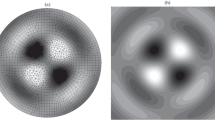Abstract
A finite difference method is developed to study, on a two-dimensional model, the acoustic pressure radiated when a thin elastic plate, clamped at its boundaries, is excited by a turbulent boundary layer.
Consider a homogeneous thin elastic plate clamped at its boundaries and extended to infinity by a plane, perfectly rigid, baffle. This plate closes a rectangular cavity. Both the cavity and the outside domain contain a perfect fluid. The fluid in the cavity is at rest. The fluid in the outside domain moves in the direction parallel to the system plate/baffle with a constant speed. A turbulent boundary layer develops at the interface baffle/plate. The wall pressure fluctuations in this boundary layer generates a vibration of the plate and an acoustic radiation in the two fluid domains.
Modeling the wall pressure fluctuations spectrum in a turbulent boundary layer developed over a vibrating surface is a very complex and unresolved task. Ducan and Sirkis [1] proposed a model for the two-way interactions between a membrane and a turbulent flow of fluid. The excitation of the membrane is modeled by a potential flow randomly perturbed. This potential flow is modified by the displacement of the membrane. Howe [2] proposed a model for the turbulent wall pressure fluctuations power spectrum over an elastomeric material. The model presented in this article is based on a hypothesis of one-way interaction between the flow and the structure: the flow generates wall pressure fluctuations which are at the origin of the vibration of the plate, but the vibration of the plate does not modify the characteristics of the flow.
A finite difference scheme that incorporates the vibration of the plate and the acoustic pressure inside the fluid cavity has been developed and coupled with a boundary element method that ensures the outside domain coupling. In this paper, we focus on the resolution of the coupled vibration/interior acoustic problem. We compare the results obtained with three numerical methods: (a) a finite difference representation for both the plate displacement and the acoustic pressure inside the cavity; (b) a coupled method involving a finite difference representation for the displacement of the plate and a boundary element method for the interior acoustic pressure; (c) a boundary element method for both the vibration of the plate and the interior acoustic pressure.
A comparison of the numerical results obtained with two models of turbulent wall pressure fluctuations spectrums - the Corcos model [3] and the Chase model [4] - is proposed. A difference of 20 dB is found in the vibro-acoustic response of the structure. In [3], this difference is explained by calculating a wavenumber transfer function of the plate. In [6], coupled beam-cavity modes for similar geometry are calculated by the finite difference method.
Similar content being viewed by others
References
Ducan, J.H. and Sirkis, J.S., The generation of wave patterns on anisotropic coatings by pressure fluctuations in a turbulent boundary layer. Journal of Sound and Vibrations 15(2) (1992) 243–264.
Howe, M.S., The wall-pressure spectrum in turbulent flow over a randomly inhomogeneous elastic solid. Journal of the Acoustical Society of America 91(1) (1992) 91–98.
Corcos, G.M., Resolution of pressure in turbulence. Journal of the Acoustical Society of America 35(2) (1963) 192–199.
Chase, D.M., The character of the turbulent wall pressure spectrum at subconvective wavenumbers and a suggested comprehensive model. Journal of Sound and Vibration 112 (1987) 125–147.
Mazzoni, D., Sur le rayonnement acoustique de sources aléatoires: Problème direct et problème inverse. Thèse, réf. 2079448, Institut de Mécanique de Marseille, Université d'Aix-Marseille, II, France (1994).
Kristiansen, U., A finite difference scheme for the coupled plate/cavity problem — A 2D example. Journal of Sound and Vibration (1997) submitted.
Davies, H.G., Sound from turbulent-boundary-layer-excited panels. Journal of the Acoustical Society of America 49(3) (1971) 878–889.
Robert, G., Modélisation et simulation du champ excitateur induit sur une structure par une couche limite turbulent. Thèse, réf. E.C.L. 84-02, Ecole Centrale de Lyon, France (1984).
Filippi, F. and Mazzoni, D., Noise inside a cavity due to an external turbulent boundary layer. In: Brebbia, C. (ed.), BEM16, Southampton, England, 13–15 July. Southampton (1994) pp. 47–54.
Bano, S., Marney, R., Jourdan, L. and Guibergia, J.-P., Etude théorique et expérimentale de la réponse vibroacoustique d'une plaque couplée à une cavité en fluide lourd. Journal d'Acoustique 5 (1992) 99–124.
Chase, D.M., Modeling the wavevector-frequency spectrum of turbulent boundary layer wall pressure. Journal of Sound and Vibration 70 (1980) 29–67.
Chase, D.M., The wave-vector-frequency spectrum of pressure on a smooth plane in turbulent boundary layer flow at low Mach number. Journal of the Acoustical Society of America 90(2) (1990) 1032–1040.
Krée, P. and Soize, C., Mécanique aléatoire. Dunod-Bordas, Paris (1983).
Leissa, A., Vibration of Plates. Acoustical Society of America, Ohio State University Columbus, Ohio (1993). Originally issued by NASA (1973).
Mattei, P.-O., Sound radiation by baffled and constrained plates. Journal of Sound and Vibration 179(1) (1995) 63–77.
Filippi, P. and Mazzoni, D., Response of a vibrating structure to a turbulent wall pressure: Fluid-loaded structure modes series and boundary element method. In: Inman, D., Ziegler, F. and Guran, A. (eds), Uncertainty Modeling in Finite Element, Fatigue and Stability of Structures, Series on Stability, Vibrations and Control of Systems, Vol. 9. World Scientific, Singapore (1997) pp. 117–159.
Rights and permissions
About this article
Cite this article
Mazzoni, D., Kristiansen, U. Finite Difference Method for the Acoustic Radiation of an Elastic Plate Excited by a Turbulent Boundary Layer: A Spectral Domain Solution. Flow, Turbulence and Combustion 61, 133–159 (1998). https://doi.org/10.1023/A:1026440919022
Issue Date:
DOI: https://doi.org/10.1023/A:1026440919022




